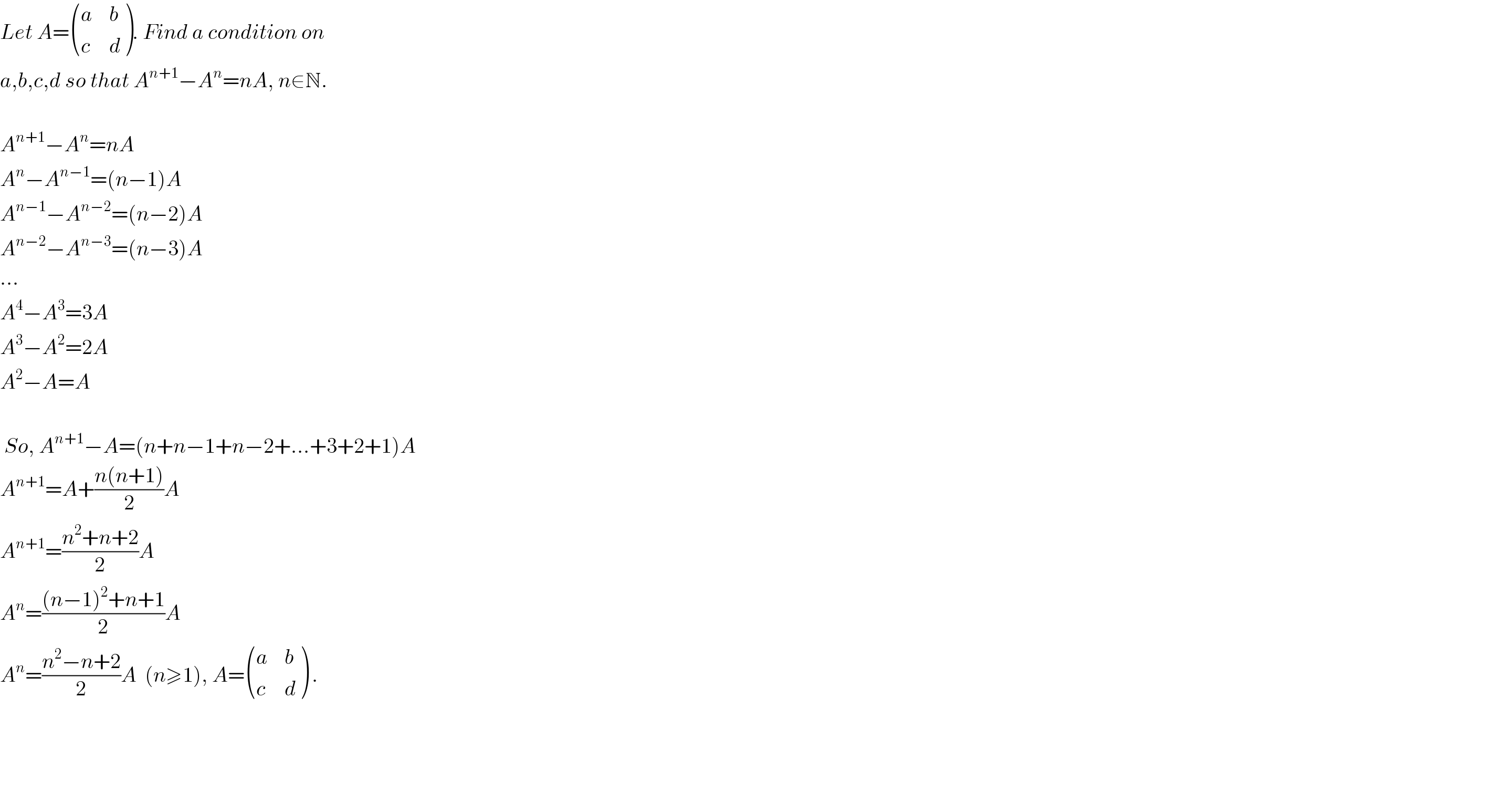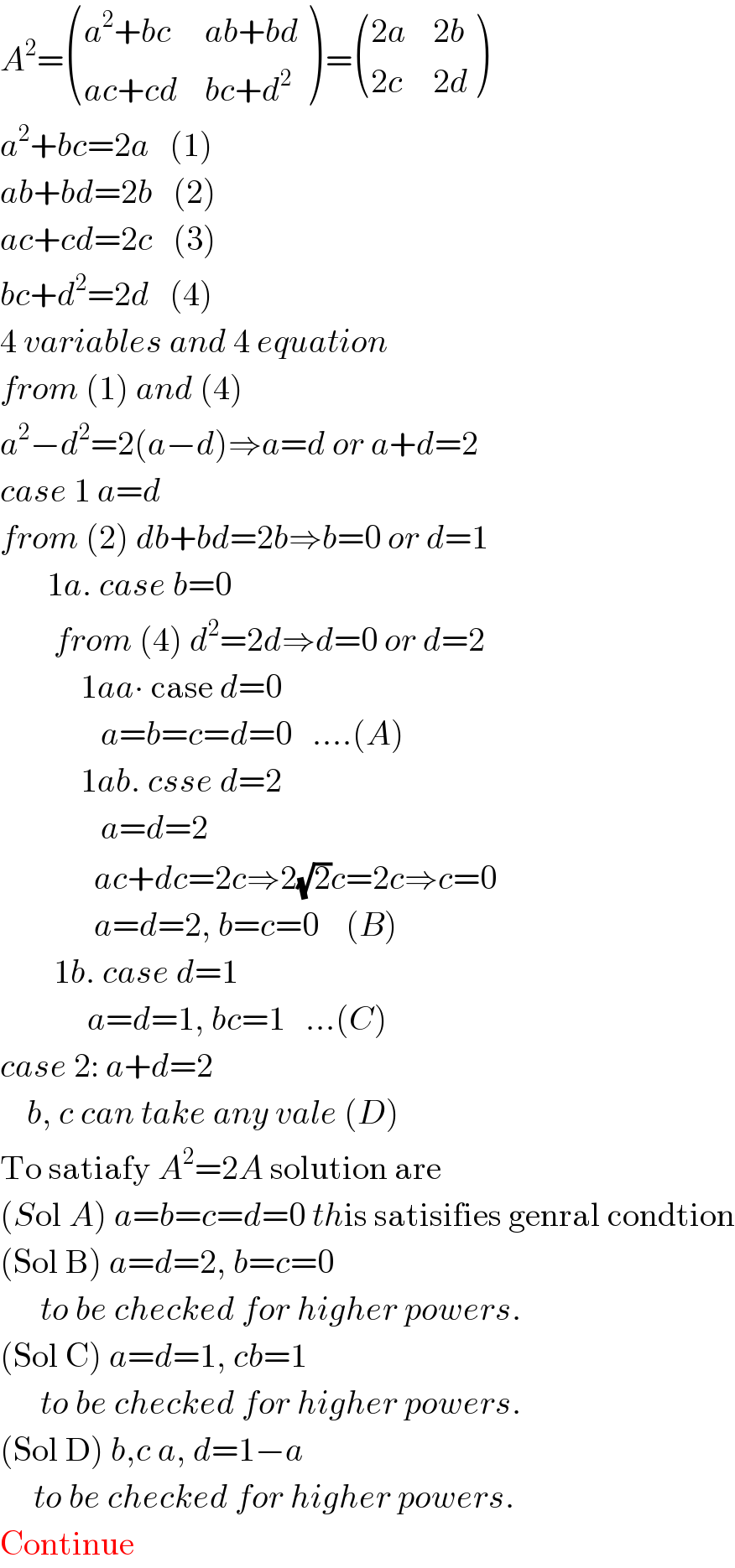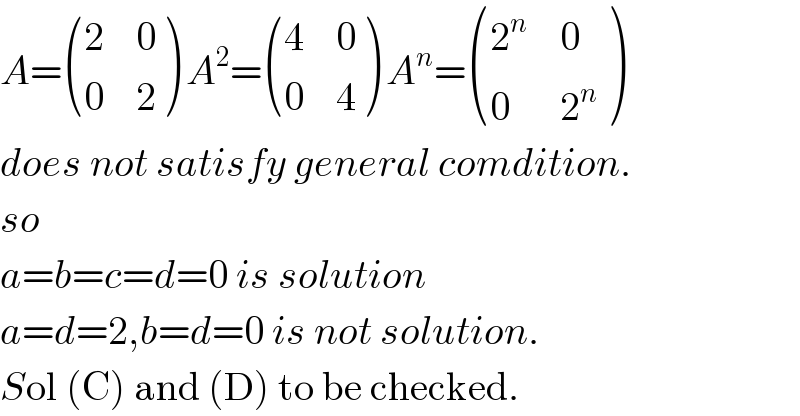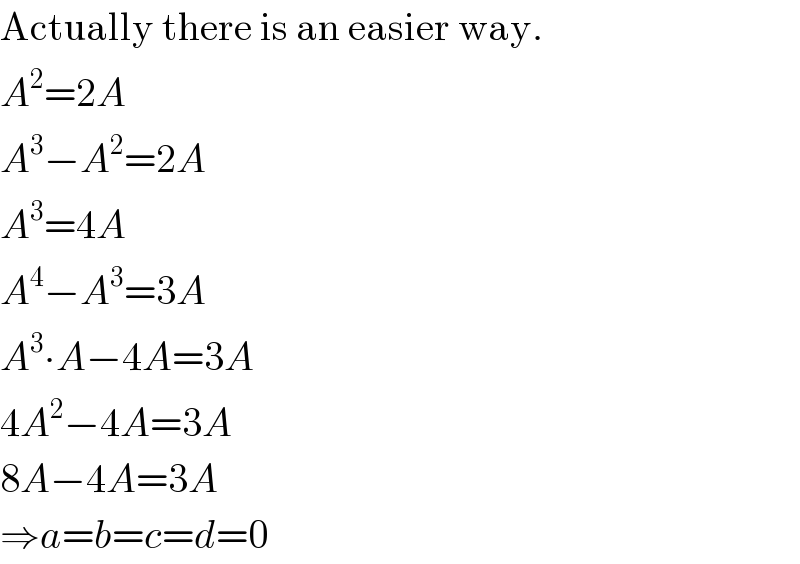
Previous in Matrices and Determinants Next in Matrices and Determinants
Question Number 3566 by Yozzii last updated on 15/Dec/15

$${Let}\:{A}=\begin{pmatrix}{{a}}&{{b}}\\{{c}}&{{d}}\end{pmatrix}.\:{Find}\:{a}\:{condition}\:{on} \\ $$$${a},{b},{c},{d}\:{so}\:{that}\:{A}^{{n}+\mathrm{1}} −{A}^{{n}} ={nA},\:{n}\in\mathbb{N}. \\ $$$$ \\ $$$${A}^{{n}+\mathrm{1}} −{A}^{{n}} ={nA} \\ $$$${A}^{{n}} −{A}^{{n}−\mathrm{1}} =\left({n}−\mathrm{1}\right){A} \\ $$$${A}^{{n}−\mathrm{1}} −{A}^{{n}−\mathrm{2}} =\left({n}−\mathrm{2}\right){A} \\ $$$${A}^{{n}−\mathrm{2}} −{A}^{{n}−\mathrm{3}} =\left({n}−\mathrm{3}\right){A} \\ $$$$... \\ $$$${A}^{\mathrm{4}} −{A}^{\mathrm{3}} =\mathrm{3}{A} \\ $$$${A}^{\mathrm{3}} −{A}^{\mathrm{2}} =\mathrm{2}{A} \\ $$$${A}^{\mathrm{2}} −{A}={A} \\ $$$$ \\ $$$$\:{So},\:{A}^{{n}+\mathrm{1}} −{A}=\left({n}+{n}−\mathrm{1}+{n}−\mathrm{2}+...+\mathrm{3}+\mathrm{2}+\mathrm{1}\right){A} \\ $$$${A}^{{n}+\mathrm{1}} ={A}+\frac{{n}\left({n}+\mathrm{1}\right)}{\mathrm{2}}{A} \\ $$$${A}^{{n}+\mathrm{1}} =\frac{{n}^{\mathrm{2}} +{n}+\mathrm{2}}{\mathrm{2}}{A} \\ $$$${A}^{{n}} =\frac{\left({n}−\mathrm{1}\right)^{\mathrm{2}} +{n}+\mathrm{1}}{\mathrm{2}}{A} \\ $$$${A}^{{n}} =\frac{{n}^{\mathrm{2}} −{n}+\mathrm{2}}{\mathrm{2}}{A}\:\:\left({n}\geqslant\mathrm{1}\right),\:{A}=\begin{pmatrix}{{a}}&{{b}}\\{{c}}&{{d}}\end{pmatrix}\:. \\ $$$$ \\ $$$$ \\ $$$$ \\ $$
Commented by prakash jain last updated on 15/Dec/15

$${A}^{\mathrm{2}} =\begin{pmatrix}{{a}^{\mathrm{2}} +{bc}}&{{ab}+{bd}}\\{{ac}+{cd}}&{{bc}+{d}^{\mathrm{2}} }\end{pmatrix}\:=\begin{pmatrix}{\mathrm{2}{a}}&{\mathrm{2}{b}}\\{\mathrm{2}{c}}&{\mathrm{2}{d}}\end{pmatrix} \\ $$$${a}^{\mathrm{2}} +{bc}=\mathrm{2}{a}\:\:\:\left(\mathrm{1}\right) \\ $$$${ab}+{bd}=\mathrm{2}{b}\:\:\:\left(\mathrm{2}\right) \\ $$$${ac}+{cd}=\mathrm{2}{c}\:\:\:\left(\mathrm{3}\right) \\ $$$${bc}+{d}^{\mathrm{2}} =\mathrm{2}{d}\:\:\:\left(\mathrm{4}\right) \\ $$$$\mathrm{4}\:{variables}\:{and}\:\mathrm{4}\:{equation} \\ $$$${from}\:\left(\mathrm{1}\right)\:{and}\:\left(\mathrm{4}\right) \\ $$$${a}^{\mathrm{2}} −{d}^{\mathrm{2}} =\mathrm{2}\left({a}−{d}\right)\Rightarrow{a}={d}\:{or}\:{a}+{d}=\mathrm{2} \\ $$$${case}\:\mathrm{1}\:{a}={d} \\ $$$${from}\:\left(\mathrm{2}\right)\:{db}+{bd}=\mathrm{2}{b}\Rightarrow{b}=\mathrm{0}\:{or}\:{d}=\mathrm{1} \\ $$$$\:\:\:\:\:\:\:\mathrm{1}{a}.\:{case}\:{b}=\mathrm{0} \\ $$$$\:\:\:\:\:\:\:\:{from}\:\left(\mathrm{4}\right)\:{d}^{\mathrm{2}} =\mathrm{2}{d}\Rightarrow{d}=\mathrm{0}\:{or}\:{d}=\mathrm{2} \\ $$$$\:\:\:\:\:\:\:\:\:\:\:\:\mathrm{1}{aa}\centerdot\:\mathrm{case}\:{d}=\mathrm{0} \\ $$$$\:\:\:\:\:\:\:\:\:\:\:\:\:\:\:{a}={b}={c}={d}=\mathrm{0}\:\:\:....\left({A}\right) \\ $$$$\:\:\:\:\:\:\:\:\:\:\:\:\mathrm{1}{ab}.\:{csse}\:{d}=\mathrm{2} \\ $$$$\:\:\:\:\:\:\:\:\:\:\:\:\:\:\:{a}={d}=\mathrm{2} \\ $$$$\:\:\:\:\:\:\:\:\:\:\:\:\:\:{ac}+{dc}=\mathrm{2}{c}\Rightarrow\mathrm{2}\sqrt{\mathrm{2}}{c}=\mathrm{2}{c}\Rightarrow{c}=\mathrm{0} \\ $$$$\:\:\:\:\:\:\:\:\:\:\:\:\:\:{a}={d}=\mathrm{2},\:{b}={c}=\mathrm{0}\:\:\:\:\left({B}\right) \\ $$$$\:\:\:\:\:\:\:\:\mathrm{1}{b}.\:{case}\:{d}=\mathrm{1} \\ $$$$\:\:\:\:\:\:\:\:\:\:\:\:\:{a}={d}=\mathrm{1},\:{bc}=\mathrm{1}\:\:\:...\left({C}\right) \\ $$$${case}\:\mathrm{2}:\:{a}+{d}=\mathrm{2} \\ $$$$\:\:\:\:{b},\:{c}\:{can}\:{take}\:{any}\:{vale}\:\left({D}\right) \\ $$$$\mathrm{To}\:\mathrm{satiafy}\:{A}^{\mathrm{2}} =\mathrm{2}{A}\:\mathrm{solution}\:\mathrm{are} \\ $$$$\left({S}\mathrm{ol}\:{A}\right)\:{a}={b}={c}={d}=\mathrm{0}\:{th}\mathrm{is}\:\mathrm{satisifies}\:\mathrm{genral}\:\mathrm{condtion} \\ $$$$\left(\mathrm{Sol}\:\mathrm{B}\right)\:{a}={d}=\mathrm{2},\:{b}={c}=\mathrm{0} \\ $$$$\:\:\:\:\:\:{to}\:{be}\:{checked}\:{for}\:{higher}\:{powers}. \\ $$$$\left(\mathrm{Sol}\:\mathrm{C}\right)\:{a}={d}=\mathrm{1},\:{cb}=\mathrm{1} \\ $$$$\:\:\:\:\:\:{to}\:{be}\:{checked}\:{for}\:{higher}\:{powers}. \\ $$$$\left(\mathrm{Sol}\:\mathrm{D}\right)\:{b},{c}\:{a},\:{d}=\mathrm{1}−{a} \\ $$$$\:\:\:\:\:{to}\:{be}\:{checked}\:{for}\:{higher}\:{powers}. \\ $$$$\mathrm{Continue} \\ $$
Answered by prakash jain last updated on 15/Dec/15

$${A}=\begin{pmatrix}{\mathrm{2}}&{\mathrm{0}}\\{\mathrm{0}}&{\mathrm{2}}\end{pmatrix}\:{A}^{\mathrm{2}} =\begin{pmatrix}{\mathrm{4}}&{\mathrm{0}}\\{\mathrm{0}}&{\mathrm{4}}\end{pmatrix}\:{A}^{{n}} =\begin{pmatrix}{\mathrm{2}^{{n}} }&{\mathrm{0}}\\{\mathrm{0}}&{\mathrm{2}^{{n}} }\end{pmatrix} \\ $$$${does}\:{not}\:{satisfy}\:{general}\:{comdition}. \\ $$$${so}\: \\ $$$${a}={b}={c}={d}=\mathrm{0}\:{is}\:{solution} \\ $$$${a}={d}=\mathrm{2},{b}={d}=\mathrm{0}\:{is}\:{not}\:{solution}. \\ $$$${S}\mathrm{ol}\:\left(\mathrm{C}\right)\:\mathrm{and}\:\left(\mathrm{D}\right)\:\mathrm{to}\:\mathrm{be}\:\mathrm{checked}. \\ $$
Answered by prakash jain last updated on 15/Dec/15

$$\mathrm{Actually}\:\mathrm{there}\:\mathrm{is}\:\mathrm{an}\:\mathrm{easier}\:\mathrm{way}. \\ $$$${A}^{\mathrm{2}} =\mathrm{2}{A} \\ $$$${A}^{\mathrm{3}} −{A}^{\mathrm{2}} =\mathrm{2}{A} \\ $$$${A}^{\mathrm{3}} =\mathrm{4}{A} \\ $$$${A}^{\mathrm{4}} −{A}^{\mathrm{3}} =\mathrm{3}{A} \\ $$$${A}^{\mathrm{3}} \centerdot{A}−\mathrm{4}{A}=\mathrm{3}{A} \\ $$$$\mathrm{4}{A}^{\mathrm{2}} −\mathrm{4}{A}=\mathrm{3}{A} \\ $$$$\mathrm{8}{A}−\mathrm{4}{A}=\mathrm{3}{A} \\ $$$$\Rightarrow{a}={b}={c}={d}=\mathrm{0} \\ $$
